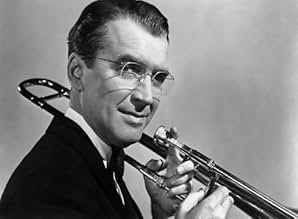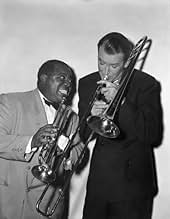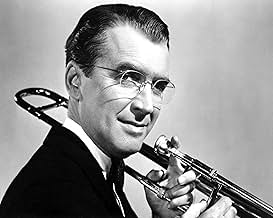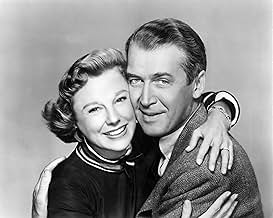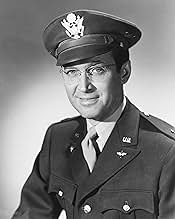AVALIAÇÃO DA IMDb
7,3/10
10 mil
SUA AVALIAÇÃO
Adicionar um enredo no seu idiomaBiography of bandleader Glenn Miller from his beginnings to his death over the English Channel in December 1944.Biography of bandleader Glenn Miller from his beginnings to his death over the English Channel in December 1944.Biography of bandleader Glenn Miller from his beginnings to his death over the English Channel in December 1944.
- Direção
- Roteiristas
- Artistas
- Ganhou 1 Oscar
- 1 vitória e 7 indicações no total
Harry Morgan
- Chummy
- (as Henry Morgan)
Katherine Warren
- Mrs. Burger
- (as Katharine Warren)
- Direção
- Roteiristas
- Elenco e equipe completos
- Produção, bilheteria e muito mais no IMDbPro
Avaliações em destaque
Glenn Miller's rise to fame and the tragedy that took him from us at the height of his career makes for a wonderfully entertaining film.
This film is rich because of the wonderful performances of James Stewart as the band leader and June Allyson, the latter was just made for the picture. She captures the depth of a devoted wife and we all can just cry with her when her happiness was ended so suddenly.
Naturally, the supporting cast of musicians and scenes with Frances Langford, Louis Armstrong and Gene Krupa are just wonderful.
We view Miller from humble beginnings to stardom, the old-fashioned Hollywood Way-he earned it by hard work and perseverance as he went through life looking for that sound.
My main flaw with this film. Just like Miller's life, it ended too suddenly. It could have gone on and on while we all danced the night away in tribute to this find musician.
Ever Harry Morgan's tear in the end tells you what this was all about.
This film is rich because of the wonderful performances of James Stewart as the band leader and June Allyson, the latter was just made for the picture. She captures the depth of a devoted wife and we all can just cry with her when her happiness was ended so suddenly.
Naturally, the supporting cast of musicians and scenes with Frances Langford, Louis Armstrong and Gene Krupa are just wonderful.
We view Miller from humble beginnings to stardom, the old-fashioned Hollywood Way-he earned it by hard work and perseverance as he went through life looking for that sound.
My main flaw with this film. Just like Miller's life, it ended too suddenly. It could have gone on and on while we all danced the night away in tribute to this find musician.
Ever Harry Morgan's tear in the end tells you what this was all about.
It is said that Miller could never remember precisely the moment he decided to emphasize his new reed section sound... But it was during this disheartening interim, that he realized the unique sound, produced by the clarinet holding the melodic line while the tenor sax plays the same note, and supported harmonically by three other saxophones - just might be the individual and easily recognizable style that would set his band apart from all the rest...
Photographed in color, Anthony Mann's 'The Glenn Miller Story' is purely a time trip to those years, when Glenn Miller's band ruled the record charts and anchored the airwaves... The film, beautifully captured Miller's spirit and follows his life story with reasonable fidelity... It is one of the most charming and touching musical biography...
Appearing in glasses and winning grin, Stewart kisses Allyson, holding her face lightly with his fingers, the same way he detains his trombone slide... Stewart applied his natural musical expertise, playing on the trombone... Miller's style was there. The original sound was there. The real music was there. The mix was there...
The film traces Miller's romance and marriage to his college sweetheart, Helen Burger, and his progress from a free-lance trombonist and arranger to band leader...
The pop music styles of '20s sweet and jazz bands were getting ready for the Big Band or Swing era of the '30s... About this time, Miller began writing charts that would one day to be his band's stock in fame, the clarinet "lead" sound over the saxophones... Miller's imagination, strong will, and determination kept his aspirations alive.. His music, a careful mixture of swing, jazz, and improvisation, flowed like spring with matchless string of hit records ( "Moonlight Serenade," "String of Pearls," "Pennsylvania 6-5000", "Little Brown Jug," "In the Mood," & "Chattanooga Choo Choo," among others...
The constant impact of radio broadcasts, and the drawing power at dance pavilions built and sustained the momentum of Miller's popularity...
June Allyson, who regularly played the little, lip-quivering waiting wife, again she is the petite and husky-voiced woman who, once married, is supportive and inspirational.. She finances Glenn what he needs to start his own band... Her scenes with Stewart have such a natural, easy-going on the screen, that we get completely drawn into their lives... Also featuring in the film are such legendary figures as Frances Langford, Gene Krupa, and Louis Armstrong...
With its unique jazz sound, 'The Glenn Miller Story' is a competent musical heart warmer with a well-cast star and successful reproduction of the Miller sound...
Photographed in color, Anthony Mann's 'The Glenn Miller Story' is purely a time trip to those years, when Glenn Miller's band ruled the record charts and anchored the airwaves... The film, beautifully captured Miller's spirit and follows his life story with reasonable fidelity... It is one of the most charming and touching musical biography...
Appearing in glasses and winning grin, Stewart kisses Allyson, holding her face lightly with his fingers, the same way he detains his trombone slide... Stewart applied his natural musical expertise, playing on the trombone... Miller's style was there. The original sound was there. The real music was there. The mix was there...
The film traces Miller's romance and marriage to his college sweetheart, Helen Burger, and his progress from a free-lance trombonist and arranger to band leader...
The pop music styles of '20s sweet and jazz bands were getting ready for the Big Band or Swing era of the '30s... About this time, Miller began writing charts that would one day to be his band's stock in fame, the clarinet "lead" sound over the saxophones... Miller's imagination, strong will, and determination kept his aspirations alive.. His music, a careful mixture of swing, jazz, and improvisation, flowed like spring with matchless string of hit records ( "Moonlight Serenade," "String of Pearls," "Pennsylvania 6-5000", "Little Brown Jug," "In the Mood," & "Chattanooga Choo Choo," among others...
The constant impact of radio broadcasts, and the drawing power at dance pavilions built and sustained the momentum of Miller's popularity...
June Allyson, who regularly played the little, lip-quivering waiting wife, again she is the petite and husky-voiced woman who, once married, is supportive and inspirational.. She finances Glenn what he needs to start his own band... Her scenes with Stewart have such a natural, easy-going on the screen, that we get completely drawn into their lives... Also featuring in the film are such legendary figures as Frances Langford, Gene Krupa, and Louis Armstrong...
With its unique jazz sound, 'The Glenn Miller Story' is a competent musical heart warmer with a well-cast star and successful reproduction of the Miller sound...
James Stewart in one of his best roles of the 1950s playing the late bandleader in the embellished story of his life; June Allyson plays his wife one of her best roles and I believe one of her personal favourites.
Watching the real Miller in Orchestra Wives' and then watching this, Stewart is really a revelation in this role. All the hits of the band are represented Moonlight Serenade, In The Mood, Tuxedo Junction, Chattanooga Choo-Choo, Pennsylvania 65000. Some artistic licence has been taken but the whole is funny, celebratory, and at the end fairly touching. One of the best Hollywood biopics, right in the middle of a glut of them (Love Me or Leave Me, With a Song In My Heart, The Eddy Duchin Story, Night and Day, Words and Music, Three Little Words ).
Watching the real Miller in Orchestra Wives' and then watching this, Stewart is really a revelation in this role. All the hits of the band are represented Moonlight Serenade, In The Mood, Tuxedo Junction, Chattanooga Choo-Choo, Pennsylvania 65000. Some artistic licence has been taken but the whole is funny, celebratory, and at the end fairly touching. One of the best Hollywood biopics, right in the middle of a glut of them (Love Me or Leave Me, With a Song In My Heart, The Eddy Duchin Story, Night and Day, Words and Music, Three Little Words ).
The Glenn Miller Story is a biographical tribute to a man who is always ranked as one of the great swing bandleaders of the late thirties to middle forties era. It is indeed fortunate that when James Stewart puts a pair of glasses on, he does actually look like the real Glenn Miller. I don't know what Helen Miller looked like, but I'm sure she was as supportive to her husband as June Allyson was to her screen hubby.
The Miller story begins with Stewart and pal Harry Morgan on the road as musicians. Stewart plays a slide trombone and has ideas of how the orchestra should sound as a whole. He spends a lot of time writing arrangements for the entire band. When they're not done right as is graphically shown in a scene when Miller's famous Moonlight Serenade is performed, he decides to form his own band.
He's still looking for that particular sound that he wants his orchestra to have and he chances on it in one of the more interesting scenes in the film. Swing fans when they hear it will recognize it as the genuine Glenn Miller.
One glaring fault for purists though is while the instrumentals are performed nicely, the vocal part of the Miller band is left out of the film. For whatever reason singers, Ray Eberle, Marian Hutton (Betty's sister)and most of all Gordon "Tex" Beneke are not in the film. In fact Chattanooga Choo Choo, Beneke's most famous number, is performed in the film by Frances Langford as herself.
My favorite scene in the film is the nightclub scene in Harlem on the Miller wedding night. June was definitely a patient wife, but hey, if you got a chance to jam with Louis Armstrong, you drop EVERYTHING for that opportunity. Gene Krupa and other top jazz musicians are in that scene with Stewart and Satchmo, making it a real treat for jazz aficionados.
For American music we are indeed fortunate that Glenn Miller succeeded in his quest for the right sound which is so lovingly captured in this film.
The Miller story begins with Stewart and pal Harry Morgan on the road as musicians. Stewart plays a slide trombone and has ideas of how the orchestra should sound as a whole. He spends a lot of time writing arrangements for the entire band. When they're not done right as is graphically shown in a scene when Miller's famous Moonlight Serenade is performed, he decides to form his own band.
He's still looking for that particular sound that he wants his orchestra to have and he chances on it in one of the more interesting scenes in the film. Swing fans when they hear it will recognize it as the genuine Glenn Miller.
One glaring fault for purists though is while the instrumentals are performed nicely, the vocal part of the Miller band is left out of the film. For whatever reason singers, Ray Eberle, Marian Hutton (Betty's sister)and most of all Gordon "Tex" Beneke are not in the film. In fact Chattanooga Choo Choo, Beneke's most famous number, is performed in the film by Frances Langford as herself.
My favorite scene in the film is the nightclub scene in Harlem on the Miller wedding night. June was definitely a patient wife, but hey, if you got a chance to jam with Louis Armstrong, you drop EVERYTHING for that opportunity. Gene Krupa and other top jazz musicians are in that scene with Stewart and Satchmo, making it a real treat for jazz aficionados.
For American music we are indeed fortunate that Glenn Miller succeeded in his quest for the right sound which is so lovingly captured in this film.
Were Jimmy Stewart and June Allyson made for the movie,or what?!
Great movie,lovely music!One of those movies that make you feel good all over,with a beautiful blend if wit,emotion and the Blues!What is even more impressive is the use of African American actors,considering the movie was made in 1954.The Jimmy and June combination evokes the chemistry of a Kate and Spencer movie.A true classic in every way,I'd watch it again in a heartbeat!
Great movie,lovely music!One of those movies that make you feel good all over,with a beautiful blend if wit,emotion and the Blues!What is even more impressive is the use of African American actors,considering the movie was made in 1954.The Jimmy and June combination evokes the chemistry of a Kate and Spencer movie.A true classic in every way,I'd watch it again in a heartbeat!
Você sabia?
- CuriosidadesJames Stewart took trombone lessons in order to actually play during scenes where Glenn Miller is seen performing with his orchestra. However, while learning from his tutor, Stewart's attempts at practicing the instrument made such horrible noises that the teacher reportedly went home in a rage every night to his family. It was decided that Stewart would accurately mime the motions of playing (especially apparent during the performance of String of Pearls) while his trombone tutor Joe Yukl did the actual playing.
- Erros de gravaçãoMiller's famed swing instrumental of "Little Brown Jug" is depicted in the closing scene as a "special arrangement" Glenn created for a Christmas 1944 radio broadcast by Miller's AAF Band from Paris. In fact, it was one of the real Miller Band's first bona fide hits in 1939, arranged by the recently hired Bill Finegan, who became, along with arranger Jerry Gray, two of the key behind-the-scenes craftsmen that helped mold Miller's civilian band into the enduring commercial and artistic powerhouse it became.
- Citações
[repeated line]
Helen Burger: Honestly!
- Versões alternativasMost current prints in circulation are the slightly shortened 113-minute 1959 re-release version.
- ConexõesFeatured in AFI Life Achievement Award: A Tribute to James Stewart (1980)
- Trilhas sonorasBasin Street Blues
(uncredited)
Written by Spencer Williams
Performed by Louis Armstrong and Gene Krupa
Principais escolhas
Faça login para avaliar e ver a lista de recomendações personalizadas
Detalhes
Bilheteria
- Faturamento bruto mundial
- US$ 994
- Tempo de duração1 hora 55 minutos
Contribua para esta página
Sugerir uma alteração ou adicionar conteúdo ausente




